Xiaomi Statistics By Revenue, Market Share and Facts (2025)
Updated · Nov 03, 2025

Table of Contents
- Introduction
- Editor’s Choice
- About Xiaomi
- Fun Facts About Xiaomi
- History of Xiaomi
- How Xiaomi Earns?
- Xiaomi Revenue
- Xiaomi Revenue By Segments
- Global Financial Analyses of Xiaomi
- Xiaomi’s Regional Market Share
- Xiaomi’s Networth
- Smartphone Market Share
- Xiaomi’s Mobile Vendor Market Share Statistics
- By Region (2025)
- By Country (2025)
- Xiaomi Shipment Statistics
- Website Traffic Statistics of Xiaomi
- By Country
- By Demographics
- By Marketing Channels Distribution
- By Social Network Distribution
- By Device
- Conclusion
Introduction
Xiaomi Statistics: The well-known brand Xiaomi quickly grew from a phone maker into a wide-reaching technology company. Besides smartphones, it also builds smart home gear, wearables, and other everyday gadgets that connect through the internet. The company primarily focuses on new ideas and delivers powerful features in products people can afford, which has helped it grow in Asia, Europe, and other fast-developing markets.
Xiaomi links its phones to smart devices to create a connected home experience and invests heavily in research to improve its products. Xiaomi prioritizes its users, builds strong community ties, and works toward greener practices. Together, these articles represent how its efforts make it a major player shaping how people use connected technology in daily life.
Editor’s Choice
- According to TelecomLead, Xiaomi achieved strong growth in Q1 2025, reporting total revenue of USD 15.4 billion (up by 47% year over year).
- Over the same period, Xiaomi remained a major global player, ranking third worldwide with a 14.1% share of smartphone shipments, up 0.3% year-on-year.
- As of February 2025, Xiaomi’s market value was approximately USD 137 billion, representing a 26.27% year-over-year increase, and ranking it the 124th-largest globally.
- The company now operates around 235 sales centres across 65 cities.
- In the fourth quarter of 2024, Xiaomi ranked third largest smartphone brands, capturing 12.9% market share.
- As of September 2025, total visits to Xiaomi.com reached 9.4 million, representing a 4.9% decrease from the previous year.
- The website’s bounce rate stood at 30.53%.
- China accounted for the largest share of web traffic, with 66.94% of visits, although this figure decreased by 3.24% from the previous month.
- The highest age group of website visitors on Xiaomi.com was 25 to 34 years old, with a share of 30.56%.
- YouTube accounted for the highest social media traffic share in September 2025, with 46.05%, followed by WhatsApp web app (29.42%).
- The graph above shows that in September 2025, Xiaomi.net received 705.08K visits, with a bounce rate of 64.97%.
- According to its investor site ir.mi.com, Xiaomi shipped 41.8 million phones in Q1 2025.
About Xiaomi
| Metrics | Details |
|
Name |
Xiaomi Corporation |
| Founded |
6 April 2010 |
|
Headquarters |
Beijing, China |
| Trade Name |
Mi |
|
Native Name |
小米集团 |
| Romanized Name |
Xiǎomǐ |
|
Type |
Public company |
| Products |
Mobile phones, Personal computers, IoT devices, and Electric vehicles |
|
Brands |
Mijia, POCO, and Redmi |
| Traded As |
SEHK: 1810 |
|
Index Component |
Hang Seng Index |
| Industry |
Consumer electronics, Computer hardware, Automotive |
|
Founders |
Lei Jun, Lin Bin, Zhou Guangping, Liu De, Li Wanqiang, Wong Kong-Kat, Hong Feng, and Wang Chuan |
| Key People |
Lei Jun (Founder, Chairman & CEO), Lin Bin (Co-founder & Vice-chairman), Lu Weibing (Partner & President), Liu De (Co-founder, Executive Director & SVP). |
|
Subsidiaries |
Black Shark, Xiaomi Auto, Zhigu Corporation, and ZMI |
| Website |
mi.com |
Fun Facts About Xiaomi
- Name meaning. “Xiaomi” literally means “millet” in Chinese. Lei Jun has linked “mi” to “mobile internet” and “mission impossible,” reflecting a start-small, tackle-hard-problems ethos.
- Founding. The company was founded in April 2010 by Lei Jun and partners in Beijing, and rapidly diversified from software to hardware.
- Global top-three smartphone brand. In Q3 2025 Xiaomi ranked #3 worldwide with 13.5% share and 43.5 million shipments.
- Record-setting retail push in India. Xiaomi opened 500 Mi Stores in a single day in October 2018, earning a Guinness World Record.
- From MIUI to HyperOS. Xiaomi retired MIUI and introduced HyperOS in October 2023 to unify phones, IoT devices, and cars under one software stack.
- Early Android 16 rollout. In October 2025, Xiaomi began global deployment of Android 16 with HyperOS 3 on recent flagships.
- Electric car debut. Xiaomi’s first EV, the SU7, was unveiled in March 2024 with strong pre-order demand and multi-month delivery waits.
- Automotive ambitions. The founder stated the EV division is expected to turn profitable in H2 2025, underscoring long-term auto plans.
- In-house chips. Xiaomi started mass production of its self-developed Xring O1 mobile chip in May 2025, signalling deeper vertical integration.
- Community-driven software DNA. Xiaomi’s software journey began with MIUI, whose frequent update cadence and user feedback loops helped build a loyal fan base.
- Mission and pricing philosophy. The stated mission is to build “amazing products with honest prices” to broaden access to technology.
- Leadership profile. Founder Lei Jun is a veteran of China’s tech scene, previously leading Kingsoft and building multiple ventures before Xiaomi.
History of Xiaomi
- 2010: Xiaomi was founded in April 2010; later that year it released the first build of MIUI (August 16).
- 2011: The first smartphone, Xiaomi Mi 1, was unveiled (August 16) and went on sale in China later that year.
- 2012: Xiaomi closed a US$216 million Series C round at an implied US$4 billion valuation.
- 2013: Xiaomi expanded its portfolio with Mi 3 and a 47-inch Android Smart TV; ex-Google executive Hugo Barra joined to lead global expansion.
- 2014: International push accelerated; Xiaomi prepared its India market entry with Flipkart and unveiled the first Mi Pad tablet; the Mi Band fitness tracker debuted in July.
- 2015: Local manufacturing began in India with Redmi 2 Prime produced with Foxconn in Andhra Pradesh.
- 2017: Xiaomi became the No. 1 smartphone vendor in India (Q4 2017), overtaking Samsung, according to Canalys.
- 2018: Xiaomi listed on the Hong Kong Stock Exchange (1810.HK) on July 9, 2018.
ir.mi.com - 2019: Redmi was formalized as an independent sub-brand to focus on value devices.
- 2020: Xiaomi entered the global top three smartphone vendors for the first time (Q3 2020), overtaking Apple per Canalys.
- 2021: The company announced a US$10 billion investment plan over 10 years to build a smart EV business; Xiaomi EV Inc. was registered with 10 billion yuan capital.
- 2023: Xiaomi announced HyperOS as the successor to MIUI; it debuted with the Xiaomi 14 series in October.
- 2024: The first electric car, Xiaomi SU7, launched in China with strong initial demand and pricing positioned below Tesla’s Model 3 entry model.
- 2025: Xiaomi unveiled the YU7 electric SUV for China, targeting sales from July 2025; the firm reported substantial EV revenue growth and raised full-year delivery targets.
How Xiaomi Earns?
- Xiaomi earns most of its money from selling its wide range of products.
- Smartphones are the main source of income, with models like Mi and Redmi bringing in more than 60% of the total revenue.
- The company also makes money from Internet of Things (IoT) devices such as smartwatches, fitness bands, air purifiers, and smart bulbs.
- It provides internet-based services including mobile games, online advertisements, and cloud storage solutions.
- Xiaomi has entered the financial sector by offering digital payment options and other financial products to its customers.
Xiaomi Revenue
- For 2025, while a full-year figure is not yet published, the company achieved revenue of ¥111.3 billion in the first quarter, a growth of about 47 % compared with the same period last year.
- For 2024, Xiaomi reported revenue of ¥365.9 billion, representing a growth of approximately 35 % year-over-year.
- According to the 2023 data, Xiaomi’s smartphone segment remained the primary revenue driver with over ¥157 billion (approximately US $21.98 billion) and that accounted for about 58 % of total revenue.
- In 2015, Xiaomi achieved revenue of ¥66.81 billion.
- In 2016, revenue rose to ¥68.43 billion, showing modest growth.
- In 2017, revenue reached ¥114.62 billion, marking a substantial increase.
- In 2018, the company generated ¥174.92 billion in revenue.
- In 2019, revenue grew further to ¥205.84 billion.
- In 2020, revenue climbed to ¥245.87 billion, almost doubling from 2017.
- In 2021, Xiaomi recorded revenue of ¥328.31 billion, continuing its upward trend.
- In 2022, revenue dipped to ¥280.04 billion, signalling a downturn.
- In 2023, the company’s revenue came in at ¥270.97 billion, reflecting a further decline from the previous year.
- In 2023, total assets of Xiaomi were valued at nearly ¥324 billion.
Xiaomi Revenue By Segments
- In 2018, the smartphone segment brought in ¥113.8 billion, the IoT & lifestyle products segment earned ¥43.82 billion, the Internet services segment generated ¥15.19 billion and the others segment made ¥1.34 billion.
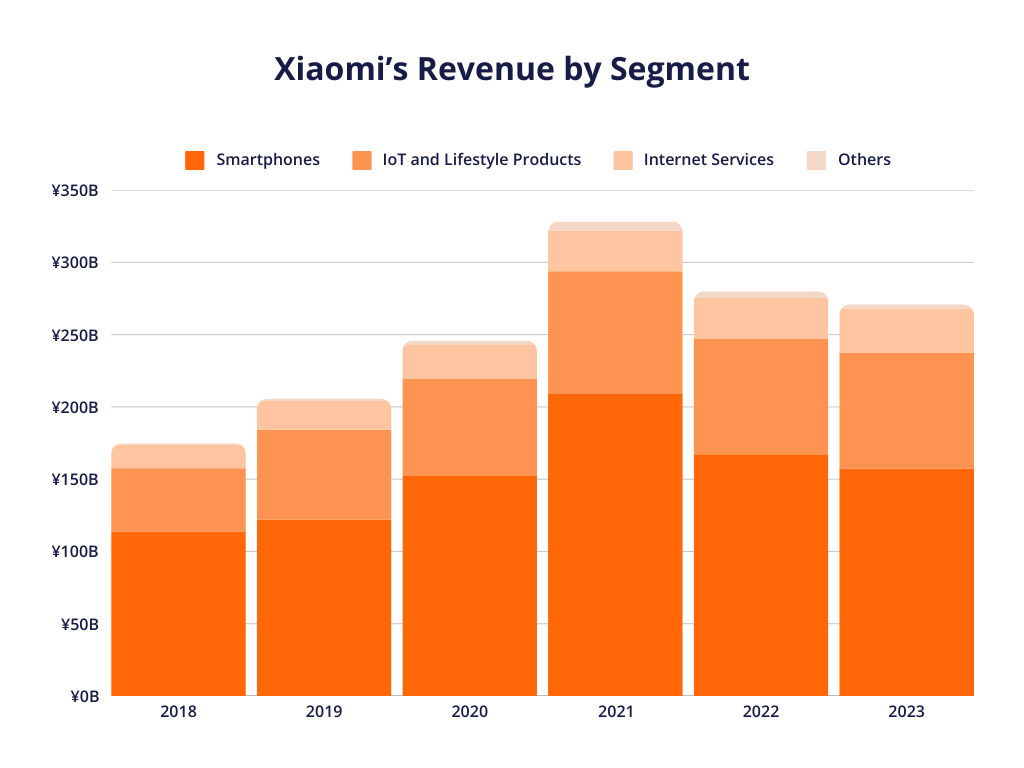
(Source: tridenstechnology.com)
- In 2019, smartphones contributed ¥122.09 billion, IoT & lifestyle products provided ¥62.09 billion, Internet services delivered ¥19.84 billion and others amounted to ¥1.81 billion.
- In 2020, the smartphone business accounted for ¥152.19 billion, IoT & lifestyle products ₹¥67.41 billion, Internet services contributed ¥23.76 billion and others made ¥2.51 billion.
- In 2021, smartphones generated ¥208.87 billion, IoT & lifestyle products ¥84.98 billion, Internet services ¥28.21 billion and others ¥6.25 billion.
- In 2022, smartphone revenue was ¥167.22 billion, IoT & lifestyle products were ¥79.79 billion, Internet services were ¥28.32 billion and others were ¥4.71 billion.
- In 2023, smartphones brought in ¥157.46 billion, IoT & lifestyle products ¥80.11 billion, Internet services ¥30.12 billion and others ¥3.29 billion.
- In 2024, the smartphone segment earned ¥191.8 billion, the IoT & lifestyle products segment brought in ¥104.1 billion and the Internet services segment generated ¥34.1 billion.
| Year | Smartphones | IoT & Lifestyle | Internet | Others |
|---|---|---|---|---|
| 2018 | ¥113.8 B | ¥43.82 B | ¥15.19 B | ¥1.34 B |
| 2019 | ¥122.09 B | ¥62.09 B | ¥19.84 B | ¥1.81 B |
| 2020 | ¥152.19 B | ¥67.41 B | ¥23.76 B | ¥2.51 B |
| 2021 | ¥208.87 B | ¥84.98 B | ¥28.21 B | ¥6.25 B |
| 2022 | ¥167.22 B | ¥79.79 B | ¥28.32 B | ¥4.71 B |
| 2023 | ¥157.46 B | ¥80.11 B | ¥30.12 B | ¥3.29 B |
Global Financial Analyses of Xiaomi
- According to TelecomLead, Xiaomi achieved strong growth in Q1 2025, reporting total revenue of USD 15.4 billion (up 47% year over year).
- Net profit reached about USD 1.5 billion, more than double the previous year.
- The smartphone division secured higher domestic demand, reaching around USD 7 billion, up 9%.
- Its IoT and lifestyle products, including air conditioners, TVs, and wearables, brought in USD 4.4 billion, up 59%, with gross margins hitting a record 25%.
- Meanwhile, EVs and new initiatives generated USD 2.6 billion in revenue, with a 23% gross margin.
- Xiaomi’s SU7 EV deliveries reached 75,800 units in Q1, with total EV sales surpassing 258,000 units.
- The company now operates around 235 sales centres across 65 cities.
- Investor confidence remained high, with Xiaomi’s stock price rising nearly 50% year to date.

- In Q1 2025, Xiaomi remained a major global player, coming third worldwide with a 14.1% share of smartphone shipments, up 0.3% year-on-year.
- Regionally, Xiaomi led in Mainland China with an 18.8% share (+4.7%), was second in both Latin America and Southeast Asia at 17.5% (+2.2% and +1%), and placed third in Europe with 20.2% (+0.1%) and in Africa with 13.2% (+2.6%).
- In India, it ranked fourth at 12.3% (up 2.2%), and in the Middle East, it ranked second at 15.7%.
- Overall, Xiaomi finished in the top three in 58 markets and the top five in 68 markets.
Xiaomi’s Networth
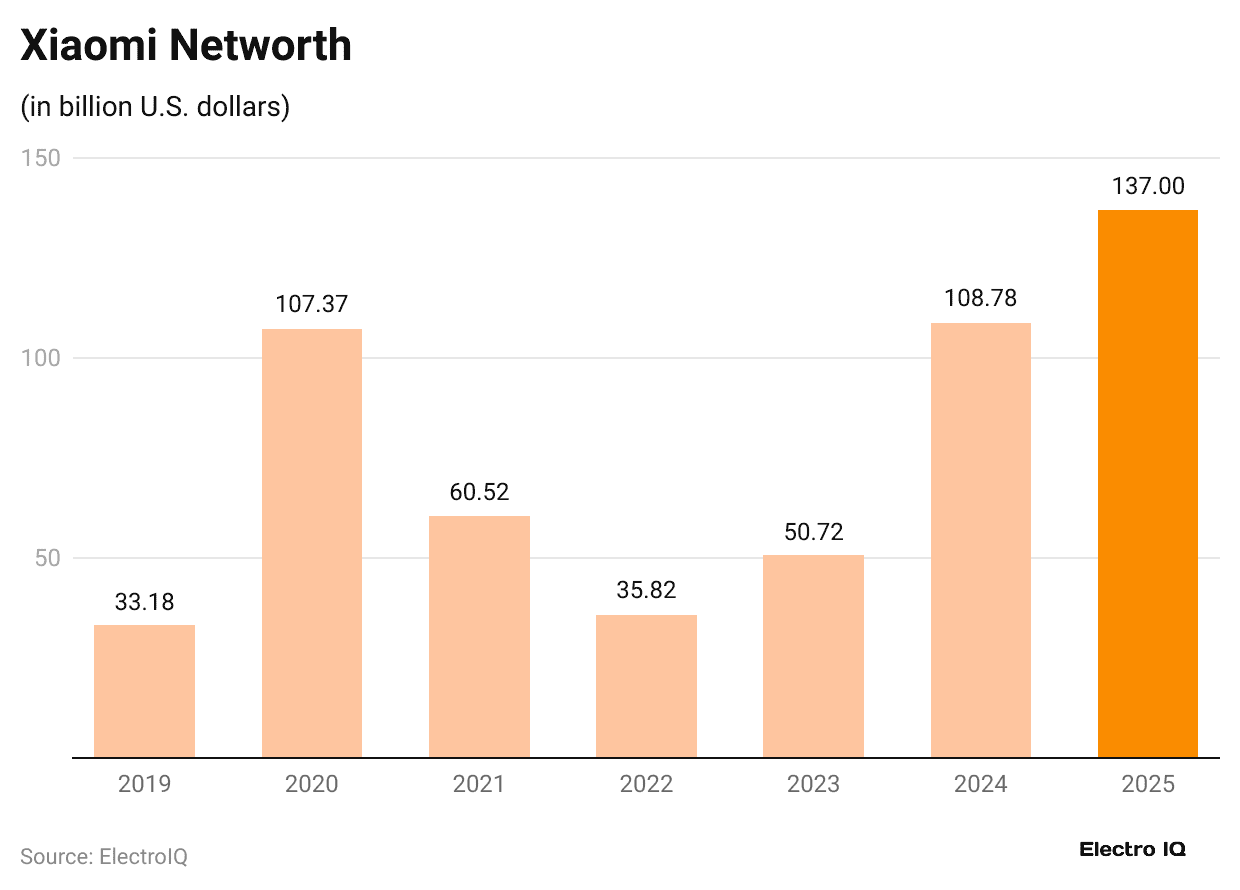
- As of February 2025, Xiaomi’s market value was about USD 137 billion, up 26.27% year over year, ranking it the 124th-largest globally.
The historical net worth of Xiaomi is stated in the table below:
| Year | Networth (USD billion) | Change |
| 2024 | 108.78 | 114.47% |
| 2023 | 50.72 | 41.60% |
| 2022 | 35.82 | -40.81% |
| 2021 | 60.52 | -43.63% |
| 2020 | 107.37 | 223.55% |
| 2019 | 33.18 | – |

- In the fourth quarter of 2024, Xiaomi ranked third largest smartphone brands with a market share of 12.9%.
- Apple and Samsung occupied the top two positions, with market shares of 23.2% and 15.6%, respectively.
- The smartphone market is also comprised of Transsion
- and Vivo, both sharing an 8.2% market share, along with other brands claiming 32%.

- As of September 2025, Xiaomi’s mobile market share accounted for 9.76%, down from 10.81% in August.
In the previous years, market shares in 2025 are stated in the table below:
| Months | Market Share |
| January | 11.95% |
| February | 11.39% |
| March | 11.2% |
| April | 11.17% |
| May | 11.7% |
| June | 12.05% |
| July | 10.84% |
By Region (2025)
| Months | Asia | North America | South America | Africa | Europe | Oceania |
| January | 14.93% | 3.58% | 17.56% | 6.41% | 13.27% | 1.17% |
| February | 14.22% | 3.13% | 17.22% | 6.61% | 13.23% | 1.13% |
| March | 14.07% | 3.13% | 17.18% | 6.21% | 12.52% | 1.23% |
| April | 14.01% | 3.02% | 15.78% | 7.46% | 11.65% | 1.17% |
| May | 14.15% | 3.43% | 19.56% | 8.78% | 11.59% | 1.03% |
| June | 14.14% | 3.81% | 20.25% | 10.23% | 11.94% | 1.19% |
| July | 13.7% | 2.65% | 14.99% | 7.44% | 11.86% | 1.06% |
| August | 13.59% | 2.65% | 13.64% | 7.4% | 11.27% | 0.64% |
| September | 11.53% | 2.46% | 11.56% | 7.38% | 11.09% | 0.92% |
By Country (2025)
| Months | United States Of America | India | Germany | United Kingdom | Canada |
| January | 1.93% | 18.79% | 10.83% | 1.97% | 1.49% |
| February | 1.74% | 18.71% | 11.31% | 1.95% | 1.49% |
| March | 1.67% | 18.32% | 11.08% | 1.84% | 1.43% |
| April | 1.71% | 18.11% | 10.85% | 1.78% | 1.41% |
| May | 1.73% | 17.94% | 10.51% | 1.69% | 1.42% |
| June | 1.73% | 17.76% | 11.17% | 1.82% | 1.49% |
| July | 1.7% | 17.49% | 11.64% | 1.86% | 1.49% |
| August | 1.76% | 17.18% | 11.98% | 1.8% | 1.78% |
| September | 1.62% | 12.38% | 10,62% | 1.95% | 2.27% |
Xiaomi Shipment Statistics
- According to its investor site ir.mi.com, Xiaomi shipped 41.8 million phones in Q1 2025.
- For all of 2024, the company moved 168.5 million units, per Technology Inquirer.
- In Q4 2023, Xiaomi shipped roughly 40.5 million units (Xiaomi group announcement).
- Annual shipments in 2020 were about 149.4 million units, as reported in industry summaries and noted on Wikipedia.
Website Traffic Statistics of Xiaomi
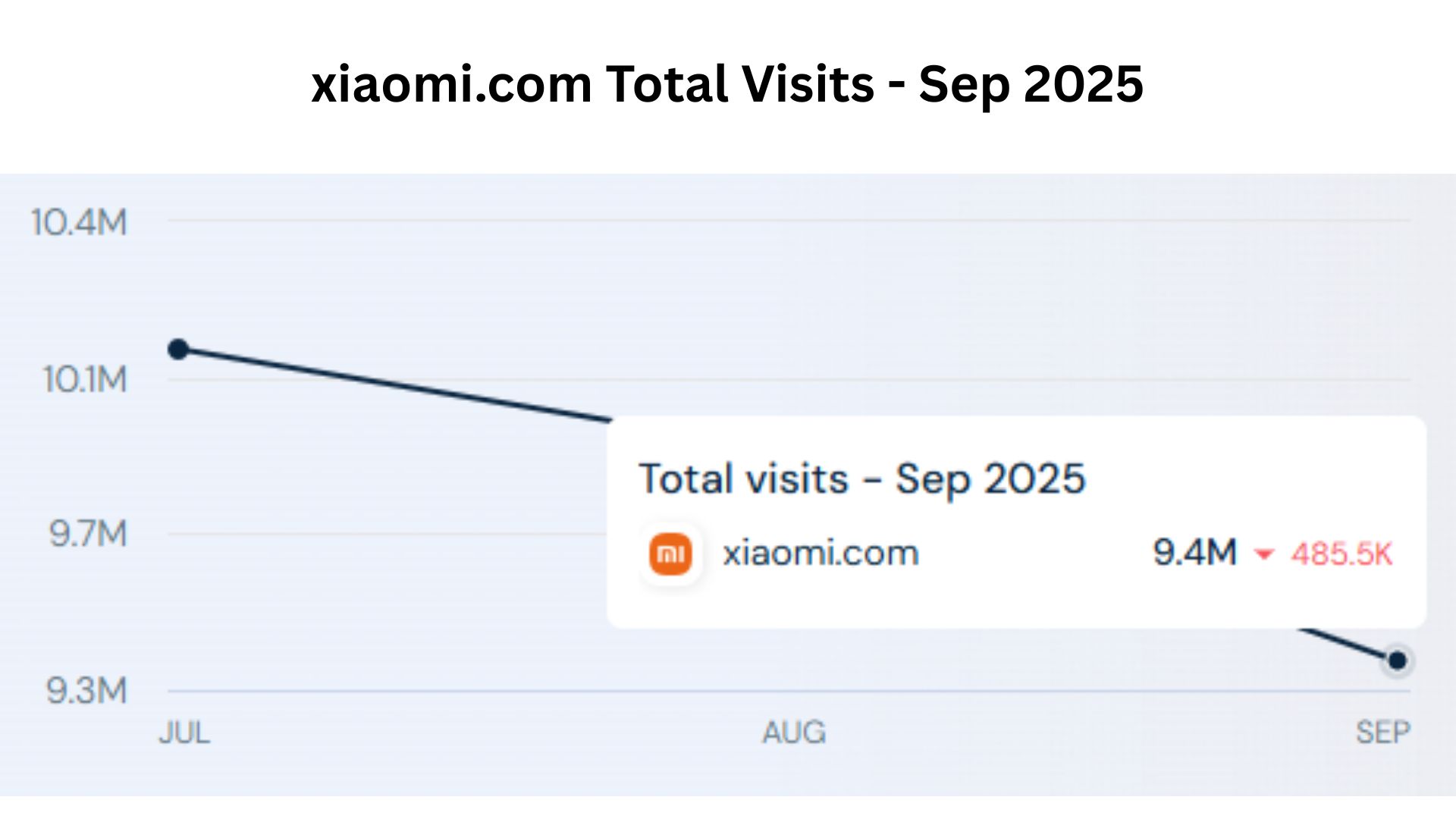
- As of September 2025, total visits to xiaomi.com were around 9.4 million, down by 4.9% from last month, while the bounce rate was 30.53%.
- The total pages per visit were 6.52, and the average visit duration was 00:05:44.
- The website’s global rank was #4,428; country-wise ranked #173 (China); and category-wise ranked #42.
- In 2025, the global ranking of xiaomi.com increased from 4,404 to 4,428 between July and September.
By Country

- In September 2025, China ranked first in website visits, with a web traffic share of 66.94%, down 3.24% from last month.
- The next top four countries by website traffic were India: 4.79% (+18.07%), Russia: 2.31% (+3.18%), Taiwan: 1.98% (+0.27%), and Germany: 1.89% (+27.43%).
- Lastly, other countries togetherly secured a traffic share of 22.1%.
By Demographics
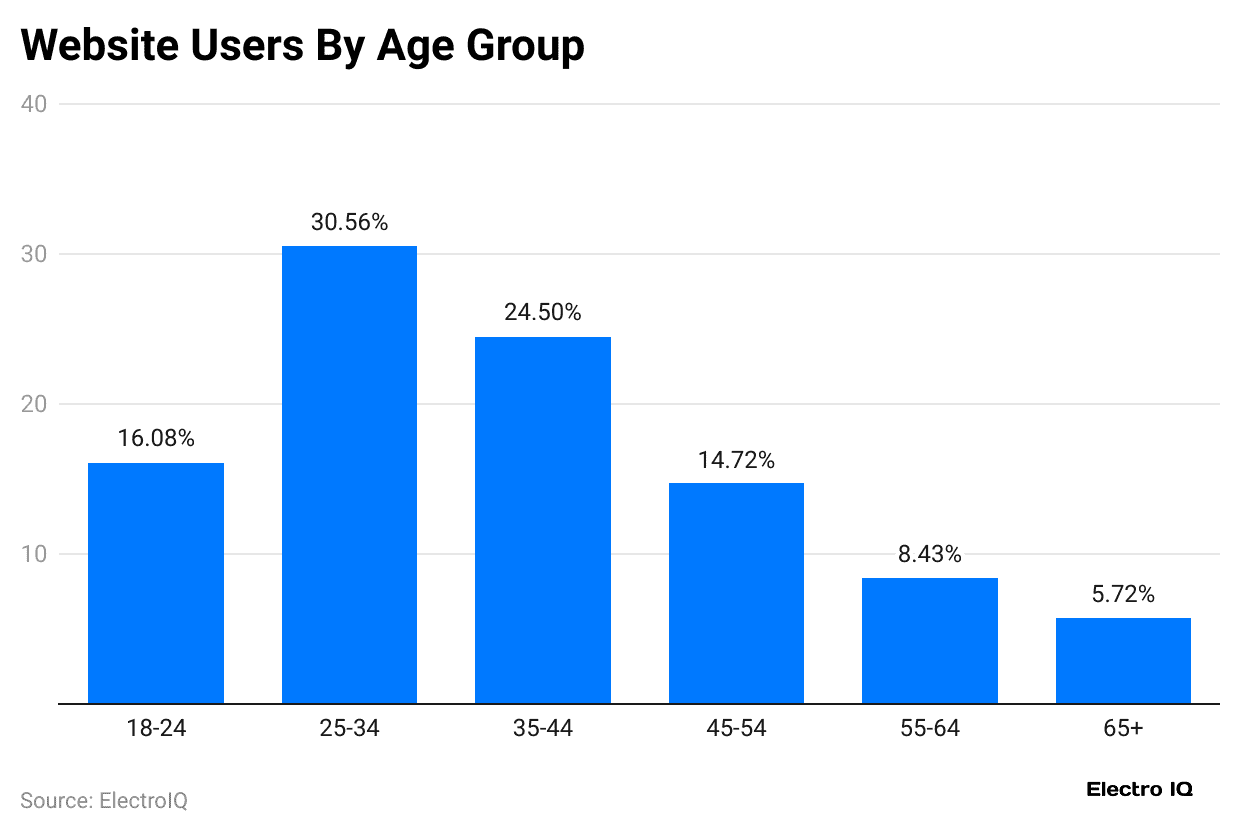
- The highest age group of website visitors on Xiaomi.com was 25-34 years old, with a 30.56% share in September 2025.
- Furthermore, other age groups’ website traffic is followed by 35 to 44 years (24.5%), 18 to 24 years (16.08%), 45 to 54 years (14.72%), 55 to 64 years (8.43%), and 65+ years (5.72%).
- com’s visitors are mostly men (67.41%) and women (32.59%).
By Marketing Channels Distribution

- In the same period above, direct visits accounted for 62.49% of Xiaomi.com’s desktop traffic, making it the top source, while organic search accounted for 26.39% of visits.
- Meanwhile, other traffic sources are followed by referrals (10.42%), social (0.43%), display (0.13%), and paid search (0.12%).
By Social Network Distribution
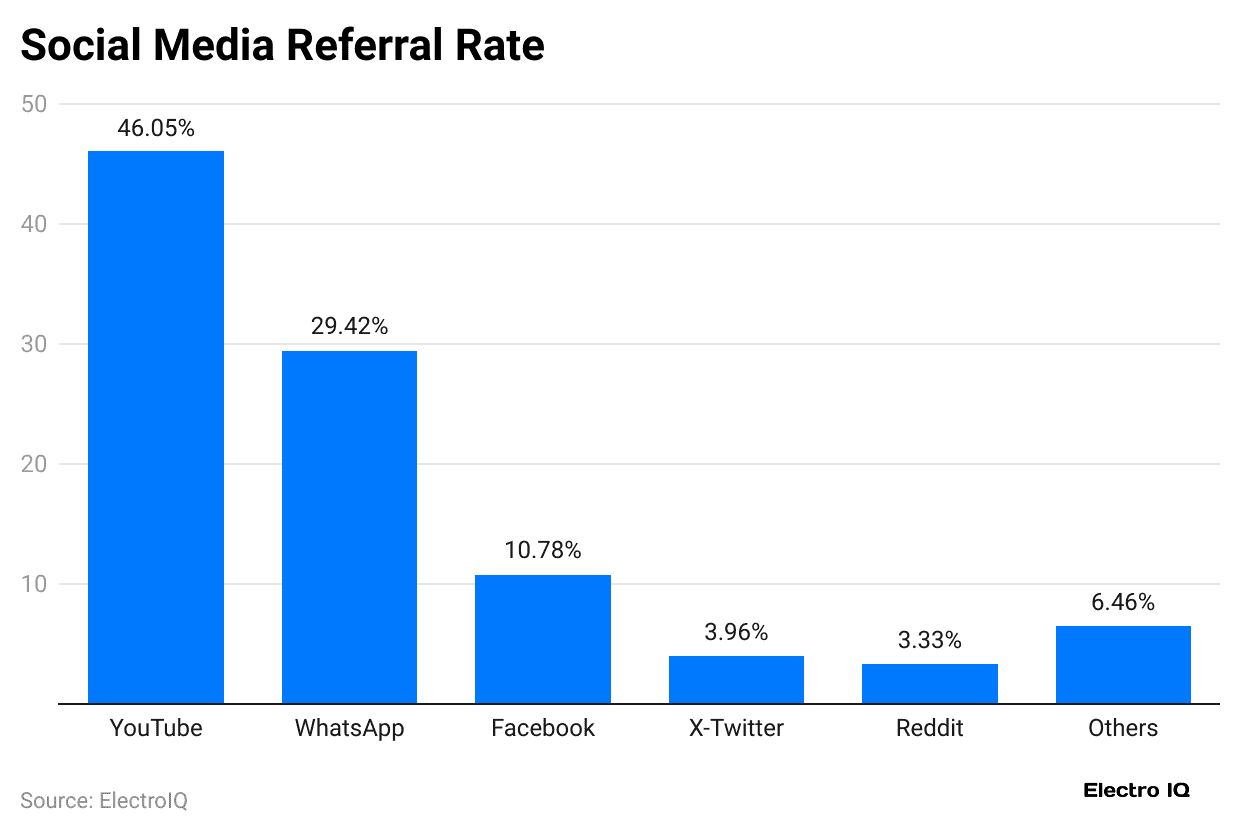
- YouTube accounted for the highest social media traffic share in September 2025, with 46.05%, followed by WhatsApp web app (29.42%).
- Moreover, other social media’s website traffic shares are followed by Facebook (10.78%), X-twitter (3.96%), Reddit (3.33%), and the rest (6.46%).
By Device

- The graph above shows that in September 2025, Xiaomi.net received 705.08K visits, with a bounce rate of 64.97%.
- The average visit duration was 10 minutes and 44 seconds, and the average number of pages per visit was 2.88.
- Desktops account for 63.39% of visits to xiaomi.net, while mobile devices make up the remaining 36.61%.
| Country | Visitor’s Share | All devices (Thousands) | Desktop | Mobile |
| China | 60.34% | 425.42 | 100% | 0.0% |
| India | 19.52% | 137.62 | 0.54% | 99.46% |
| Spain | 7.39% | 52.08 | 0.0% | 100% |
| Italy | 4.57% | 32.23 | 0.57% | 99.43% |
| Hong Kong | 3.83% | 27.02 | 38.63% | 61.37% |
Conclusion
After completing the article on Xiaomi Statistics, it can be concluded that the company is growing into a stronger global tech company by making smart, affordable products and building a connected device ecosystem. The firm is now more towards AIoT features, releasing higher-end phones, and adopting sustainable business practices to create lasting value.
It is doing well in emerging markets and is slowly moving into premium categories to challenge other big brands. As Xiaomi develops more smart home gadgets, electric vehicles, and AI-powered services, its clear focus on new technology and practical pricing should help it keep growing in the changing tech world ahead.
Sources
FAQ.
Xiaomi offers smartphones, smart TVs, wearables, smart home devices, accessories, and electric vehicles globally.
HyperOS is Xiaomi’s own operating system that seamlessly connects smartphones, services, and smart devices.
AIoT combines AI and IoT, allowing Xiaomi devices to connect and work seamlessly together intelligently.
Xiaomi Auto has begun producing electric vehicles and plans major deliveries and global expansion soon.
Xiaomi sells products globally via online stores, Mi Home outlets, and partners, expanding retail reach.

Maitrayee Dey has a background in Electrical Engineering and has worked in various technical roles before transitioning to writing. Specializing in technology and Artificial Intelligence, she has served as an Academic Research Analyst and Freelance Writer, particularly focusing on education and healthcare in Australia. Maitrayee's lifelong passions for writing and painting led her to pursue a full-time writing career. She is also the creator of a cooking YouTube channel, where she shares her culinary adventures. At Smartphone Thoughts, Maitrayee brings her expertise in technology to provide in-depth smartphone reviews and app-related statistics, making complex topics easy to understand for all readers.








